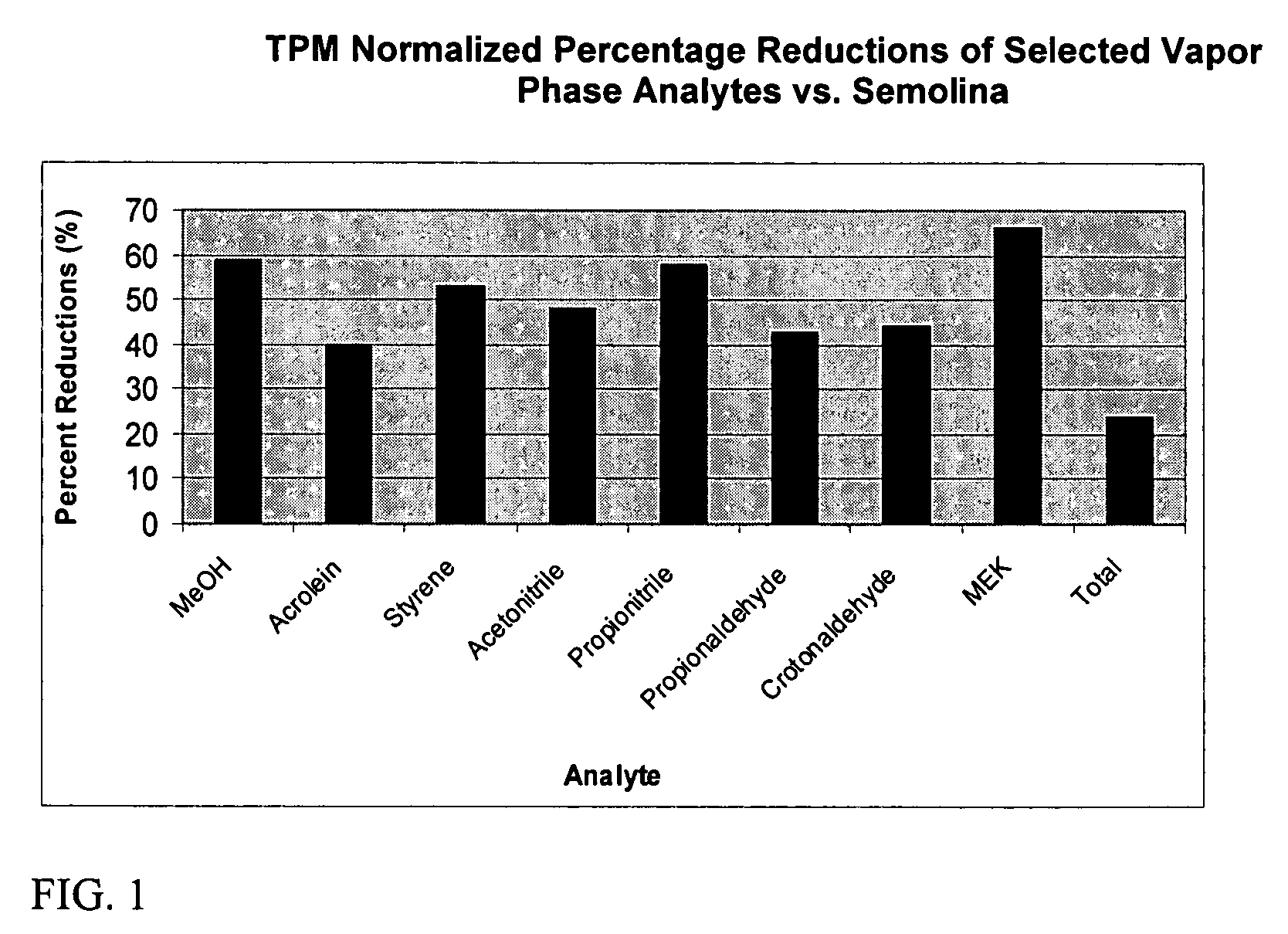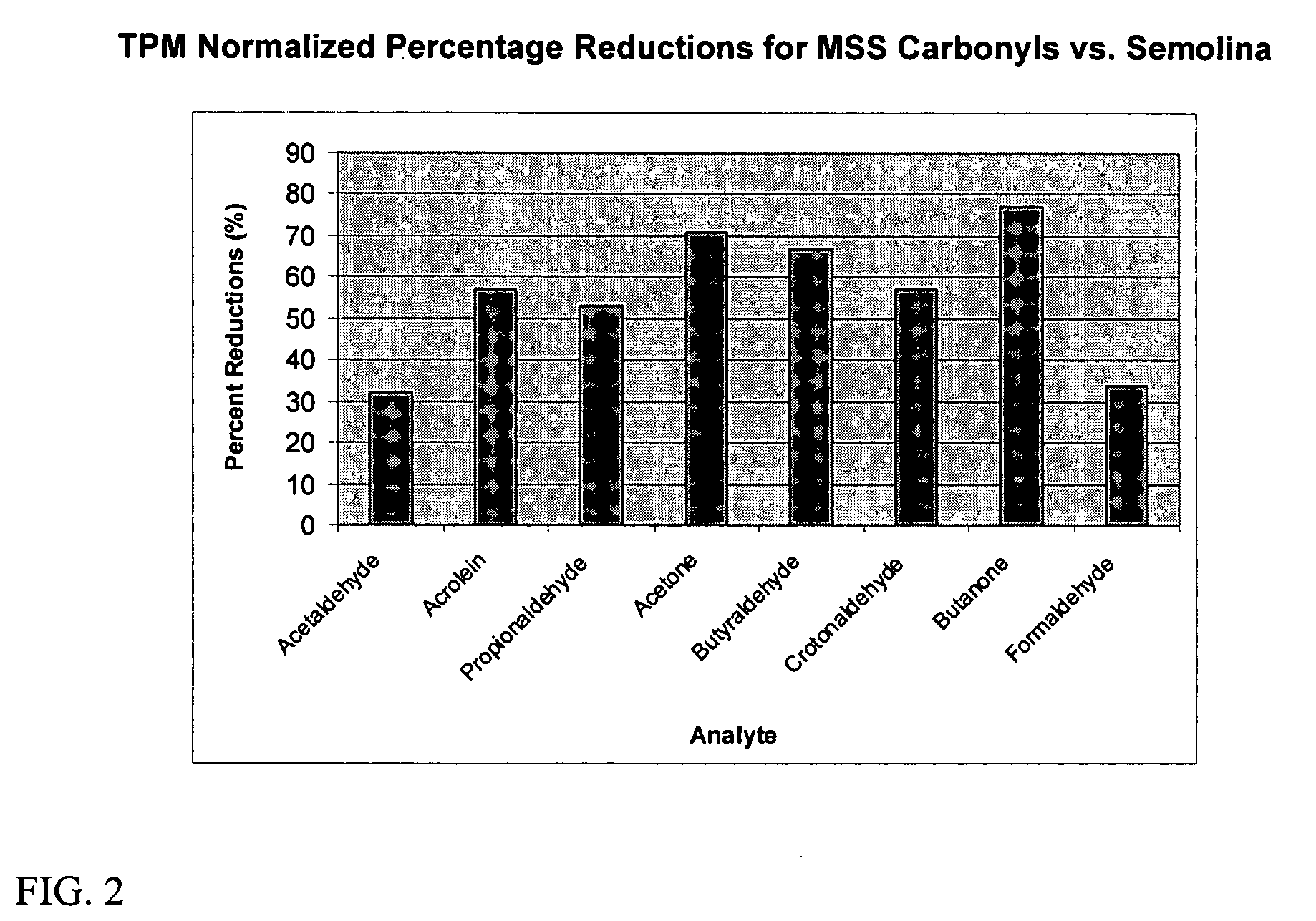Application of mesoporous molecular sieves as selective smoke filtration additives
a technology of additives and molecular sieves, applied in the field of smoking articles, can solve the problems of difficult to find a preferred flavorant loading percentage, insufficient surface area to achieve the desired filtration, and inefficient, and achieves the effects of reducing the level of alcohol, aldehydes, ketones, and large surface area
- Summary
- Abstract
- Description
- Claims
- Application Information
AI Technical Summary
Benefits of technology
Problems solved by technology
Method used
Image
Examples
example 1
MCM-41 Adsorptive Properties
[0027] To evaluate the adsorptive properties of MCM-41, MCM-41 was tested in hand-made cavity filters and compared to semolina (inert flour granules used to simulate a granule-filled cavity). Hand-made cavity filters can be made by first removing the cellulose acetate (CA) filter of a cigarette. Shortened segments of CA on the tobacco and mouth end of the filter create a cavity to hold the granular material.
[0028] The MCM-41 sample sets were prepared according to usual synthesis procedure, except for minor modifications. MCM-41 was developed by Exxon / Mobil, but sample sets for experiment purposes were developed in the laboratory. Water, the surfactant cetyltrimethyl ammonium bromide (CTAB), and tetraethyl orthosilicate (TEOS) were mixed, in order, in a 250 mL glass bottle until a cloudy white suspension was achieved. CTAB and TEOS were combined with a surfactant:silica mole ratio of 1:2. The solution's surfactant concentration, by total weight, equaled ...
example 2
MCM-41 In Comparison to Sorbite as a Cigarette Filter Additive
[0037] To evaluate the filtration efficiency of MCM-41, MCM-41 and Sorbite, a coal-based activated carbon derived from semi-anthracite coal, available from Calgon Carbons, were placed in hand-made cavity filtered cigarettes, the properties of which are explained above, and the filtration efficiencies of both were compared. Semolina was utilized as a control. The highly porous nature of MCM-41 invited the comparison to activated carbons, such as Sorbite. The MCM-41 samples were prepared according to the above-stated method. Sorbite was used without modification.
[0038] Three sample sets were prepared with hand-made cavity filtered cigarettes. TABLE D lists the filter additives and loadings for each sample:
TABLE DLoading Amounts for Filter ComponentsFilter ComponentsLoading (mg)MCM-41 / Semolina50 / 50Sorbite / Semolina50 / 50Semolina Control100
[0039] The samples were pressure drop selected to diminish variances in aerosol deliv...
example 3
Copper Oxide Impregnated MCM-41
[0047] A sample of MCM-41 was prepared using the process as described in EXAMPLE 1. Additionally, copper nitrate was introduced into the MCM-41 reaction solution with a concentration of 3% by weight. The resulting gel was calcined at 400° C., forming a copper oxide impregnated MCM-41 having the same high surface area and vapor phase capacity as pure MCM-41, but with the added ability to reduce hydrogen cyanide and hydrogen sulfide. Compared to the semolina control as previously described, copper oxide impregnated MCM-41 showed a 56% reduction in HCN ad a 35% reduction in H2S.
PUM
 Login to View More
Login to View More Abstract
Description
Claims
Application Information
 Login to View More
Login to View More - R&D
- Intellectual Property
- Life Sciences
- Materials
- Tech Scout
- Unparalleled Data Quality
- Higher Quality Content
- 60% Fewer Hallucinations
Browse by: Latest US Patents, China's latest patents, Technical Efficacy Thesaurus, Application Domain, Technology Topic, Popular Technical Reports.
© 2025 PatSnap. All rights reserved.Legal|Privacy policy|Modern Slavery Act Transparency Statement|Sitemap|About US| Contact US: help@patsnap.com



